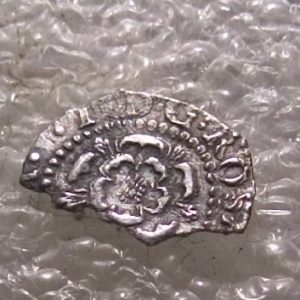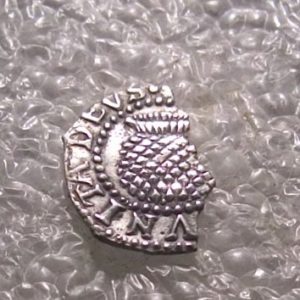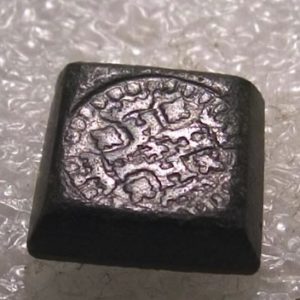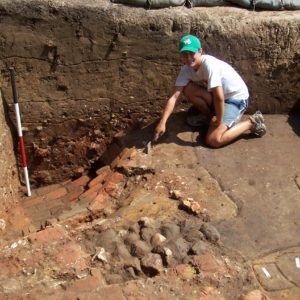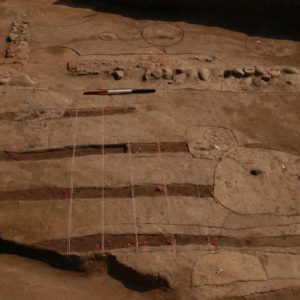Some very early features—from the first few years of the fort—have been discovered in the past month. At the northernmost end of one of the cobblestone buildings a possible well has been found. Closer to the river a pit filled with iron slag may suggest attempts at iron manufacturing. Also, close to the center of the fort, three large postholes forming a straight line have been excavated. Evidence suggests these postholes are very early and supported a substantial building—perhaps a storehouse.
Archaeologists have continued their excavations northward just inside the western palisade wall. They are following the footprint of a large cobblestone building and a brick addition to the building that approaches the northern bulwark. The brick addition has a chimney that was attached to the outside of the structure, unlike the chimneys from the main part of the building which were all inside the structure itself. A very interesting discovery has been made at this northernmost point of the excavations. Many of the bricks have fallen several feet below the floor level of the building. According to the archaeologists, this usually indicates the presence of a feature underneath the building such as a well, a cellar, or a pit. Because of the size and shape of the feature, archaeologists think they may have found a very early well. Due to the fact that this feature was underneath the brick addition to the cobblestone building—itself a fort-period structure—the possible well feature dates to very early in the fort’s history. The settlers didn’t build the first well until 1608 and had been drinking the brackish river water since landing. If this feature does turn out to be an early well, it might suggest a realization that digging wells far from the river provided healthier water. This feature is about as far from the river as possible while still remaining inside the fort’s walls.
Closer to the river, but underneath the cobblestone foundations of the same structure, a test pit of a feature has yielded many pounds of iron slag, a byproduct of attempting to smelt iron. Again, because this feature is underneath the cobblestone foundation, it predates it, and suggests a very early attempt to produce iron, perhaps by refining the naturally occurring bog iron found in the area.
Near the center of the fort three large postholes indicate the presence of a substantial building, perhaps a storehouse. The postholes are around three feet in depth and the complete lack of any historical artifacts suggests that this building was one of the first to be built. Structures built later usually yield artifacts when their foundations are excavated. This is a sign that the land being built on had been occupied previously. The postholes from this structure showed a complete lack of evidence for previous occupation by the settlers, suggesting this was the first building to be built on this spot inside the fort.
The conservators for Jamestown Rediscovery are busy preserving artifacts that will go on display in the Archaearium when it opens in 2006. Some of the objects currently in the conservation process are a number of coins and coin weights. Brass coin weights were used to test the authenticity of coins by placing the weight on one side of a scale and the coin in question on the other. One French weight being conserved was used to authenticate a gold coin known as an ecu minted during the reign of Henry II (1546-1559). On the reverse of this weight are the letters “O” “V” and “X.” An English coin weight has three “I”s on one side, the top one being crowned for “King James.” A silver penny of James I’s reign, minted between 1619 and 1625 is nearing the completion of its conservation process. The coin shows the Tudor rose on one side and the Scottish thistle on the other. A few of the other copper alloy objects being conserved include a 1601 Irish penny, a Harrington farthing ca. 1613-1614 and a Hans Krauwinckle jetton minted in Nuremberg in the late 16th century. Finally, an iron lockplate from a matchlock musket is also being conserved.
related images
- Silver penny of James I’s reign, minted between 1619 and 1625, with Tudor Rose on one side…
- and a Scottish Thistle on the other
- Coin weight for a French Ecu from the reign of Henry II (1546-1559)
- Three large postholes near the center of the fort
- Mary Anna working on brick hearth collapsed into possible well
- Cobblestone building showing foundations and dark linear floor joist stains
- Hans Krauwinckle Jetton (late 1500s) in foreground, Irish penny (1601) at top left, Harrington Farthing (1613-1614) at top right



